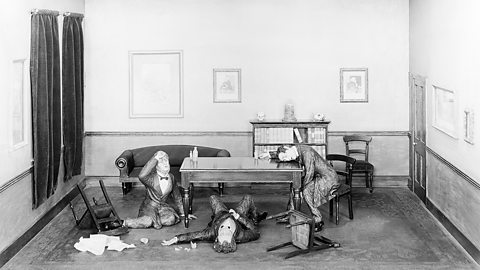The development of anaesthetics
In the early 19th century, surgeons, and more so their patients, still faced four major problems that had existed since:
- pain
- shock
- blood loss
- infection
It was difficult to operate successfully on a conscious patient. Speed was essential to keep pain and blood loss to a minimum, and a good surgeon could amputate a leg in under three minutes. However, many patients still died from shock or loss of blood, and even more died from infection after the operation. In some London hospitals, nine out of ten people died from infection.
Robert Liston
This description is of a typical operation carried out by the surgeon Robert Liston in the 1830s. From it, readers can get an idea of what surgery was like in the early 19th century.
He was six foot two, and operated in a bottle-green coat with wellington boots. He sprung across the blood-stained boards upon his swooning, sweating, strapped-down patient like a duelist, calling, ‘Time me gentlemen, time me!’ to students craning with pocket watches from the iron-railinged galleries. Everyone swore that the first flash of his knife was followed so swiftly by the rasp of saw on bone that sight and sound seemed simultaneous. To free both hands, he would clasp the bloody knife between his teeth.
Liston is also the only surgeon known to have performed an operation with a 300 per cent mortality rate. During a high-speed amputation, he cut off his assistant’s fingers and slashed the coat of a spectator, who fainted in shock. All three died - the patient and the assistant from sepsis Also referred to as blood poisoning or septicaemia. It is caused by harmful bacteria entering wounds. and the spectator from shock.
It may sound as if Liston was incompetent, but he was actually highly respected. It was the need for speed that caused the three deaths. In 1835 he became the first professor of surgery at University College London. In 1846 he carried out the first operation using anaestheticA drug that causes loss of feeling or consciousness. in Europe.
19th-century methods of anaesthesia
In the early 19th century, scientists began to experiment with anaesthetics to put patients to sleep.
Laughing gas
The first method used was laughing gas (nitrous oxide). Sir Humphrey Davy, a chemist and inventor, noticed in 1800 that breathing this gas took away the pain he was feeling from an erupting wisdom tooth. He believed the gas might help surgeons, who were forced to rush through operations to avoid causing their patients too much pain.
This was fine for pulling teeth but it could not be used for longer operations. The gas was never tried for surgery as Davy was worried it might cause patients to bleed more.
Ether
Ether was used first in America in 1846 and then by Robert Liston in London. It did knock patients out, but it was flammable and could damage the lungs.
Chloroform

In 1847, James Simpson first used chloroform successfully.
Simpson tried chloroform out on himself and two doctor friends. They tried different doses on each other until they fell completely unconscious.
As a professor of midwifery, Simpson first used chloroform to help women in labour. However, it quickly began to be used for operations. It soon became obvious that it was the most long-lasting and reliable anaesthetic. It could knock people out for longer operations and so gave surgeons more time when operating.
However, surprisingly, there were objections to the use of chloroform:
- Some surgeons preferred their patients to stay awake so that they could fight for their lives.
- Many religious people felt that pain, particularly pain experienced during childbirth, had been sent by God and should therefore not be tampered with.
- It was difficult to get the dose right. For example, 15-year-old Hannah Greener died while having her toenail removed.
Other anaesthetic drugs
Other drugs gradually began to be used for their anaesthetic properties as well. For example, cocaine began to be used as a local anaesthetic from 1884.
Black period of surgery
Ironically, the use of chloroform initially led to the ‘black period of surgery’, a 20-year period when the death rate actually went up. However, this was not the fault of Simpson or chloroform. With patients unconscious, surgeons could now take their time over operations and attempt more difficult invasive surgery A form of surgery that involves making an incision in the patient's body and inserting medical instruments into the body. Unfortunately, patients still died from blood loss or from infections picked up in the operating theatre because doctors:
- didn’t wash their hands before surgery
- might cough over patients
- wore bloody aprons as a badge of honour on the wards to show they had completed surgeries
However, chloroform was a major breakthrough and surgery improved over time:
- In the 1850s John Snow, known for his work on cholera, developed an inhaler to regulate the dosage.
- Queen Victoria had chloroform during the births of two of her children. This made chloroform more acceptable.
- Other developments, eg the use of antisepticA substance that kills or stops the growth of germs which cause disease. during surgery, reduced mortality.